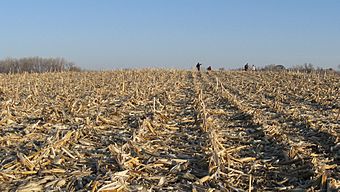Kimball Village facts for kids
|
Kimball Village
|
|
 |
|
| Location | Address restricted |
|---|---|
| Nearest city | Westfield, Iowa |
| Area | 1.9 acres (0.77 ha) |
| MPS | Archaeological Resources of Initial Variant of the Middle Missouri Tradition in Iowa MPS |
| NRHP reference No. | 10000343 |
Quick facts for kids Significant dates |
|
| Added to NRHP | June 11, 2010 |
| Designated NHL | December 23, 2016 |
Kimball Village is an archaeological site near Westfield, Iowa, in the United States. It's a special place where archaeologists study the past. This village was home to people from the Big Sioux phase of the Middle Missouri tradition. These groups lived here between the years 1100 and 1250 C.E..
The village sits on a raised area of land called a terrace, overlooking the Big Sioux River. It has many well-preserved clues about how people lived long ago. These clues include the remains of earth lodge homes and pits used for storing food. There is also evidence that the village was protected by a fence or wall. Kimball Village was recognized for its importance in 2010. It was added to the National Register of Historic Places. Later, in 2016, it became a National Historic Landmark, which is an even higher honor.
Discovering Kimball Village
Kimball Village is found in the northwest part of Iowa. It is in the countryside of Plymouth County. The site is on a terrace between the Big Sioux River and the Loess Hills. You can spot the village as a small mound in the flat river area. It covers an area of almost 2 acres.
Early Explorations
In 1939, a professor named Dr. Charles R. Keyes from Cornell College heard about old objects being found here. He decided to investigate the site. Dr. Keyes, his assistant Ellison Orr, and 14 workers began digging. These workers were part of a government program called the Works Progress Administration.
During their work, they made exciting discoveries. They found the remains of houses, cooking areas called hearths, and storage pits. They also found places where people were buried. In total, they uncovered more than 9,000 artifacts. These artifacts are objects made by people long ago.
More Recent Digs
Archaeologists returned to Kimball Village for more digs in 1942, 1963, and 2009. The 2009 investigation helped them understand how big the entire village was. These studies showed that the village had at least 20 homes. These homes were arranged in five rows, all facing south.
The village was also protected by a strong timber fence, called a palisade. It might have also had a ditch around it for extra defense. When Kimball Village was named a National Historic Landmark in 2016, it was noted how well-preserved it was. Not much of the site had been damaged by weather or time. In fact, only about 3% of the village area had been explored by archaeologists. This means there is still much more to learn about this ancient place!

